From the April 2022 issue of Apollo. Preview and subscribe here.
I am startled to see a distorted reflection of my face, funhouse-style, on the silky, bulbous walls of a Tiffany and Company gold coffee pot, on view in ‘Gold in America’. It was made in the 1910s and given to middle-aged newly-weds Alice Belin and Pierre Samuel du Pont, whose families had already intermarried while prospering in the gunpowder trade. The couple ended up collaborating on philanthropic endeavours but remained somewhat mismatched; he preferred the company of his chauffeur, Lewes Mason. During my visit to Yale I am wearing a black felt mask embroidered with Ukrainian folk flower patterns, in tribute to the besieged homeland of my mother’s parents, aunts and uncles – they escaped to New York in the early 1900s with a few souvenirs, including a gold pendant inscribed in Cyrillic with names of friends left behind. While my heirloom textile mask is mirrored in the coffee pot, I ponder Du Pont explosives and the power of gold to evoke our sources of sorrows, whether soured relationships or Putin’s hidden billions.
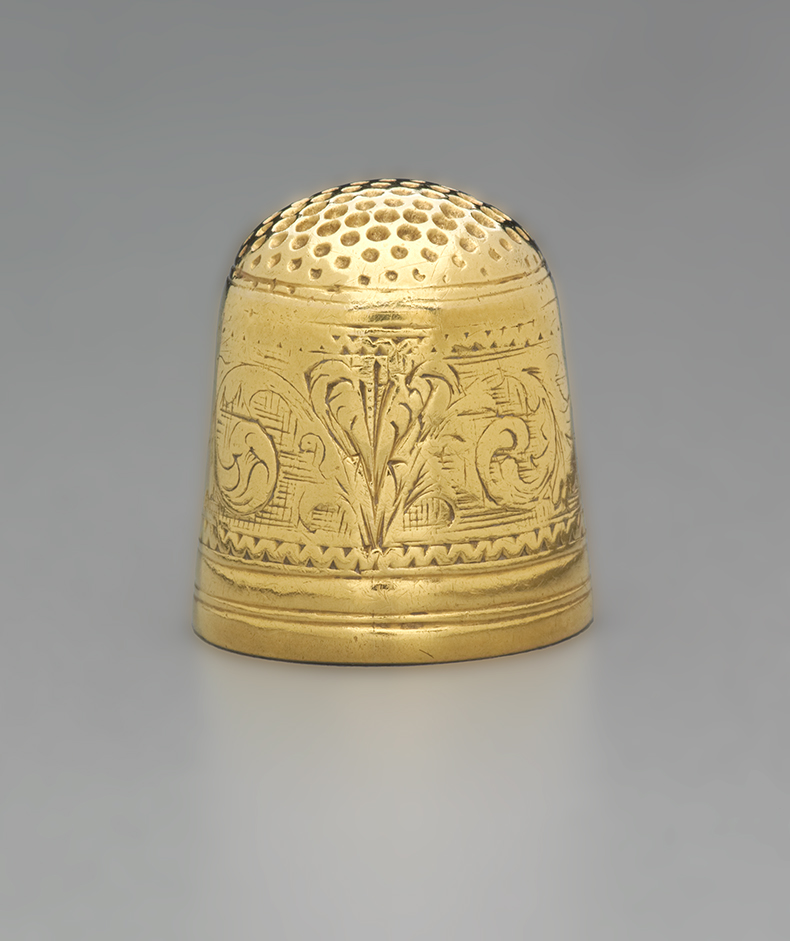
Thimble owned by Elizabeth Gooch Hubbart Franklin (1730–40), Jacob Hurd. Yale University Art Gallery, New Haven
The show’s curator, John Stuart Gordon (full disclosure: he is a friend of mine), has spent the pandemic researching and selecting about 70 objects and artworks from Yale’s holdings. (Covid scuttled his plans for a larger travelling show with loans and a catalogue.) Each item has a documented provenance, and there are many signs that past owners did not handle the treasures but instead kept them in vaults. For a number of Gordon’s selections, findings about their past owners in newly digitised archives are not flattering.
The gallery walls are painted a shade of powdery cornflower blue that makes the gold pop. Visitors should equip their phones with magnifying apps, to scrutinise intricate markings. They should also forgive themselves in advance for being irresistibly drawn to feats of craftsmanship that have unsavoury origins. Fortunately the gallery guards show mercy, and they never once reprimand me, during a two-hour stay, for getting too close to the cases.
A chunk of grey stone, excavated in North Carolina, where early 19th-century mine-owners exploited enslaved Black people, requires me to make several cranes of the neck before its gold flecks glint under the spotlights overhead. In a group photo of Utah miners, taken around 1890, the men’s faces are half concealed by industrial-strength respirators, far more functional than my patriotic Ukrainian textile. In a photograph of Alaskan scenery from 2003 by Victoria Sambunaris, mist and seemingly pristine hills encircle an opencast mine, where granite layers are pulverised by the tons every day.
Cases full of jewellery represent the enduring appeal of gold as a material to celebrate and commemorate important milestones. Bracelets and rings, often described in detail in bequest papers and newspaper crime reports, are etched with love messages or images of human bones. Medals and weaponry trimmed in gold were worn by the victors of the American Revolution. A pendant made in 1801 contains locks of blond and brown hair, arrayed in the shapes of willow trees, casting shade on the tombs of two infant brothers. A spoon from around 1830 that Gordon describes as ‘showroom new’ was the present of a Boston grandmother to an infant grandson, ‘likely a baptism gift that one-ups the adage of being born with a silver spoon in one’s mouth’, the label says.
Cutlery and shoe buckles on display can be traced back to slave-trade fortunes. Gordon names some of the human beings – including Dido, Juba, and Quashey – mentioned in archival documents, who laboured and were sold off to help finance extravagances. A painting from around 1769 by Agostino Brunias shows a gathering of free Black women in the Caribbean, gold dripping from their ears and wrists, in front of a barefoot and shirtless workman rolling a barrel along dirt streets.
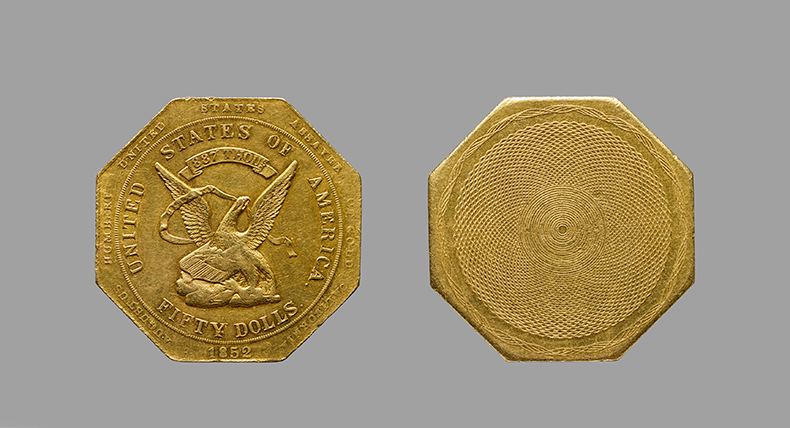
50 dollar coin (1852), George Albert Ferdinand Kuner, die cutter, Augustus G. Humbert, assayer, and United States Assay Office of Gold, mint. Yale University Art Gallery, New Haven
Elihu Vedder’s lunette painting from 1893 belonged to one of the Gilded Age’s most skilful gold-diggers, Arabella Duval Yarrington Worsham Huntington. A southern belle of mysterious origins, she surfaced in New York in the late 1860s, claiming to be married then later claiming to be a widow. She married one railway tycoon after another: Collis Huntington, who was probably the biological father of her son Archer (later renowned for founding the Hispanic Society in New York), and then Collis’s nephew Henry. Vedder’s mural, which came from Arabella’s Manhattan mansion, depicts a barefooted goddess in a billowing pink gown carrying a fistful of gold necklaces against a backdrop of gold-tipped ribbons. Another southerner transplanted to Manhattan who spoke little of her past, Hettie Anderson, the Gilded Age’s most prominent Black model, posed for an allegorical figure of striding Liberty on a $20 coin which President Theodore Roosevelt commissioned from the sculptor Augustus Saint-Gaudens. Yale has installed that coin alongside the sculptor Bela Lyon Pratt’s $5 coin, bearing the likeness of Hollow Horn Bear (Matho Hehlogeca), a Brulé Lakota chief who rode on horseback with a delegation of Native American chiefs in Roosevelt’s 1905 inaugural parade. Yale received both coins from Millicent Todd Bingham, a globetrotting geographer and expert on Emily Dickinson – her mother Mabel had been the long-time mistress of Emily’s brother Austin.
The contemporary contingent in ‘Gold in America’ combines emotional wallop with a sense of humour. Noma Copley’s bangle bracelet of 1999, inspired by Surrealism, mimics a humdrum yellow pencil, with coral representing the eraser. Lola Brooks’s forsakengardenheart (2012) brings together reminders of environmental degradation, species decimation and love’s perils; she stuffed a heart-shaped cage of metal chains with coral and ivory roses and gold bows. Olga de Amaral’s Umbra 40 (2004), a swatch of rippled textile resembling chain mail and standing nearly seven feet tall, leaves me simply wowed at first look. Only after my third circumnavigation of the gallery do I realise that De Amaral used a crimson substrate, and its edges are everywhere visible – as if blood is oozing through crevices between the gilded tesserae. How much we have craved gold, how much we think it matters, how much we suffer to get our hands on it, and how little it protects us from harm.
‘Gold in America: Artistry, Memory, Power’ is at Yale University Art Gallery until 10 July.
From the April 2022 issue of Apollo. Preview and subscribe here.
Unlimited access from just $16 every 3 months
Subscribe to get unlimited and exclusive access to the top art stories, interviews and exhibition reviews.

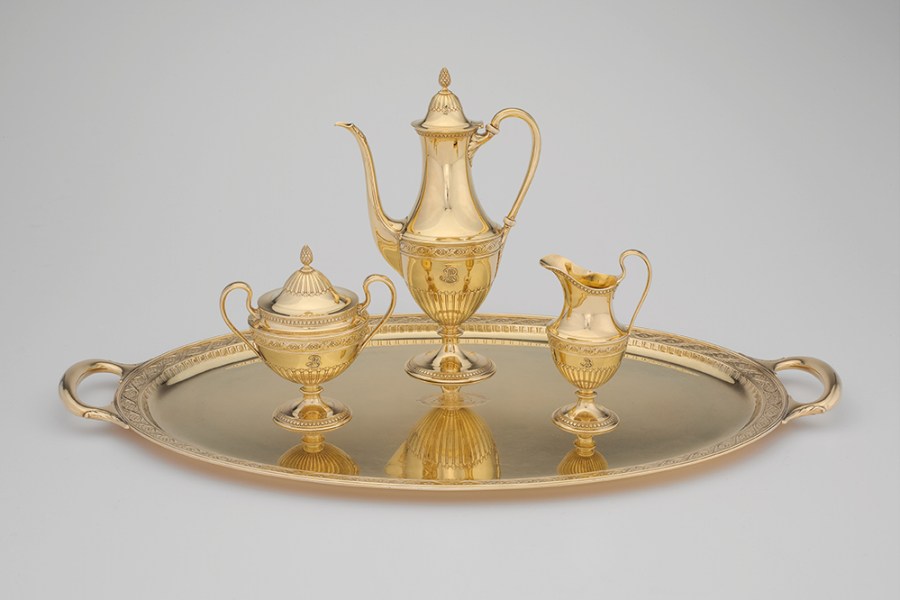
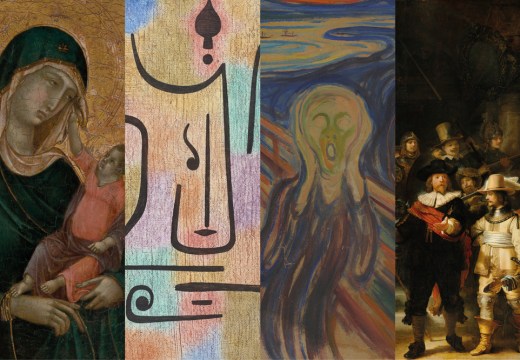

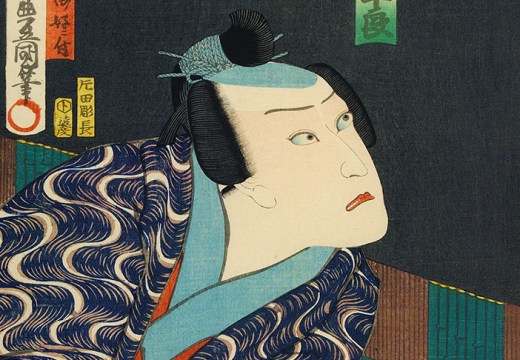









![Masterpiece [Re]discovery 2022. Photo: Ben Fisher Photography, courtesy of Masterpiece London](http://www.apollo-magazine.com/wp-content/uploads/2022/07/MPL2022_4263.jpg)
It’s time for the government of London to return to its rightful home